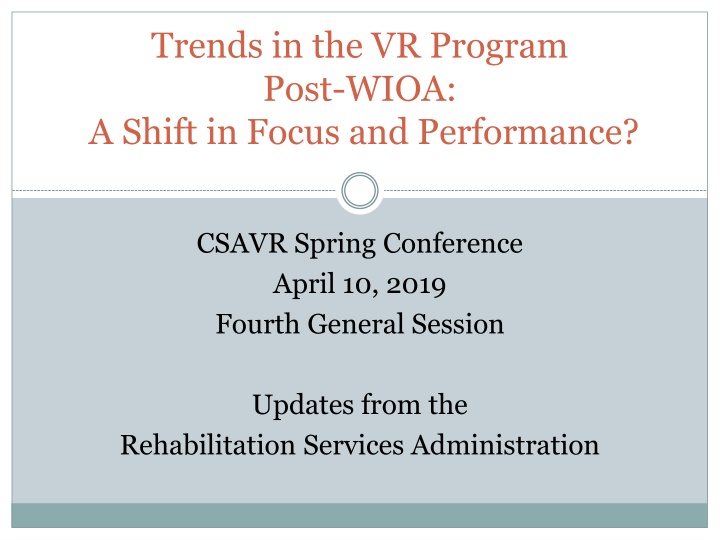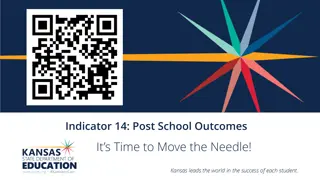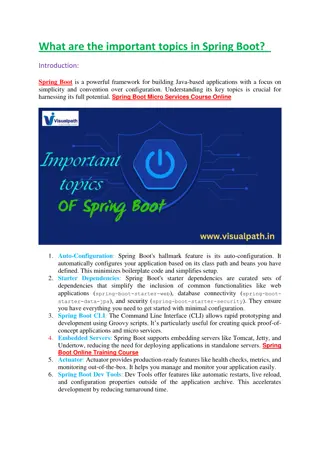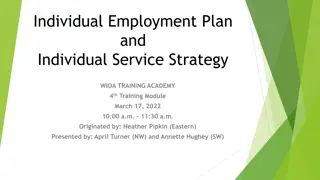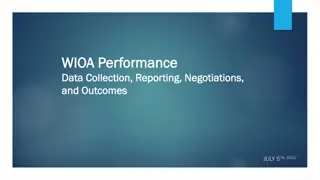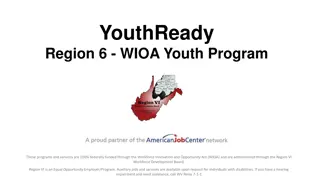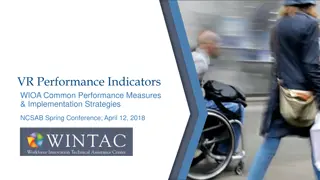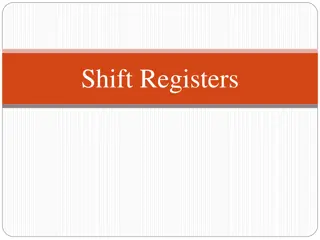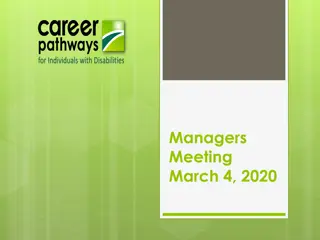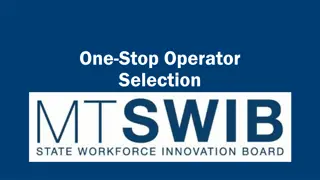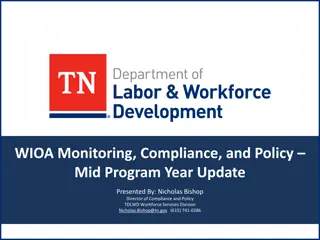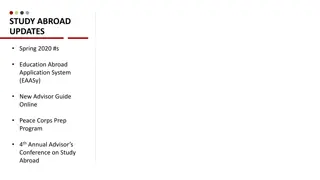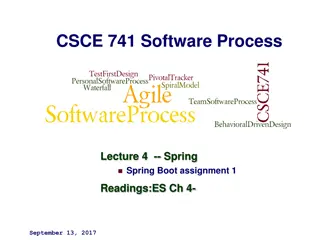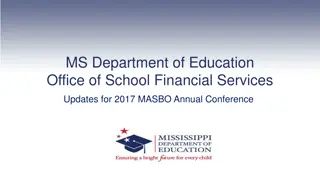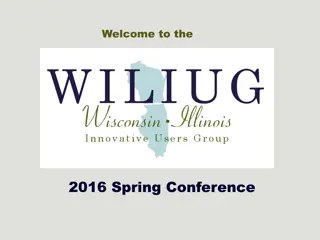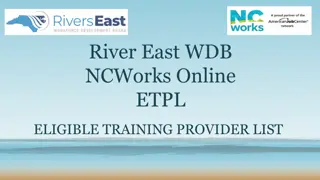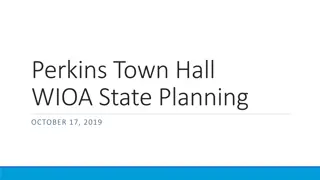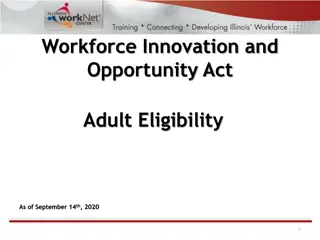Trends in VR Program Post-WIOA: Shift in Focus & Performance - CSAVR Spring Conference Updates
The CSAVR Spring Conference session provides insights on VR program data from FFY 2010-2018 and PY 2017-2018, focusing on performance perspectives. Key topics include cumulative caseload reports, employment outcomes, and pre-employment transition services. The session features expert presenters discussing trends and introducing ReThink Performance. Attendees gain valuable updates from the Rehabilitation Services Administration.
Download Presentation

Please find below an Image/Link to download the presentation.
The content on the website is provided AS IS for your information and personal use only. It may not be sold, licensed, or shared on other websites without obtaining consent from the author.If you encounter any issues during the download, it is possible that the publisher has removed the file from their server.
You are allowed to download the files provided on this website for personal or commercial use, subject to the condition that they are used lawfully. All files are the property of their respective owners.
The content on the website is provided AS IS for your information and personal use only. It may not be sold, licensed, or shared on other websites without obtaining consent from the author.
E N D
Presentation Transcript
Trends in the VR Program Post-WIOA: A Shift in Focus and Performance? CSAVR Spring Conference April 10, 2019 Fourth General Session Updates from the Rehabilitation Services Administration
Presenters Presiding: Robert Doyle State Director, Florida Blind; Past President of CSAVR Carol Dobak Acting Deputy Commissioner, delegated the authority to perform the functions and duties of the Commissioner Suzanne Mitchell Chief, Vocational Rehabilitation Program Unit RoseAnn Ashby Chief, Technical Assistance Unit David Steele Chief, Fiscal Unit Christopher Pope Chief, Data Collection and Analysis Unit Mary Lovley Acting Director, Training and Service Programs Division Corinne Weidenthal Chief, Service Programs Unit
Session Overview Welcome Review FFY 2010-2018 and PY 2017-2018 VR Program Data Review FFY 2010-2018 Fiscal Data Perspectives on Performance of the VR Program Updates from RSA s Training and Service Programs Division Introduce ReThink Performance Steve Wooderson, Chief Executive Officer, CSAVR Carol Pankow, President, NCSAB
VR Program Data: FFY 2010-2018 Quarterly Cumulative Caseload Report (RSA-113) Individuals Entering VR Program and Receiving VR Services Number of Applicants Number of Eligible Individuals Number of Eligible Individuals who Did Not Receive VR Services Percent of Total Eligible Individuals
VR Program Data: FFY 2010-2018 and PY 2017-2018 Case Service Report (RSA-911) Employment Outcomes (FFY 2010-2018) Employment Rate, Number of Individuals who Exited with Competitive Integrated Employment or Supported Employment, and Median Wages for: All Individuals; Individuals Under Age 25; Individuals Age 25 and Older FFY 2017 includes the first three quarters of RSA-911 data from PD 14-01 and the first quarter of PY 2017 data from PD 16-04 FFY 2018 includes RSA-911 data from PD 16-04 for the last three quarters of PY 2017 and the first quarter of PY 2018 Pre-Employment Transition Services (PY 2017 and the first two quarters of PY 2018) Number of Students with Disabilities Reported Number of Students with Disabilities who Received Pre-Employment Transition Services Number of Potentially Eligible Students with Disabilities who Received Pre-Employment Transition Services Number of Students with Disabilities, who applied for VR services, and Received Pre-Employment Transition Services Percentage of Students with Disabilities Reported who Received Pre-Employment Transition Services
Individuals Applying to VR Program 750,000 700,000 650,000 600,000 550,000 500,000 FFY 10 FFY 11 FFY 12 FFY 13 FFY 14 FFY 15 FFY 16 FFY 17 FFY 18
Individuals Eligible for VR Services 700,000 650,000 600,000 550,000 500,000 450,000 400,000 FFY 10 FFY 11 FFY 12 FFY 13 FFY 14 FFY 15 FFY 16 FFY 17 FFY 18
Eligible Individuals Who Received VR Services Number of Eligible Individuals with IPE who Received VR Services 1,020,000 1,000,000 980,000 960,000 940,000 920,000 900,000 880,000 FFY 10 FFY 11 FFY 12 FFY 13 FFY 14 FFY 15 FFY 16 FFY 17 FFY 18
Order of Selection (FFY 2010 FFY 2019) FFY 2010 FFY 2011 FFY 2012 FFY 2013 FFY 2014 FFY 2015 FFY 2016 FFY 2017 FFY 2018 FFY 2019 35/80 37/80 36/80 36/80 34/80 36/80 35/80 37/79 40/79 41/78 Date OOS No OOS One or more categories closed All categories closed 37 42 21 4 February 13, 2018 September 30, 2018 40 39 7 27 41 37 33 8 March 1, 2019
All Individuals: Employment Rate 58.0% 57.0% 56.9% 56.7% 56.7% 56.0% 55.7% 55.0% 54.0% 54.0% 53.6% 53.0% 52.0% 51.9% 51.0% 50.0% 49.5% 49.0% 48.0% 48.3% FFY 18 FFY 10 FFY 11 FFY 12 FFY 13 FFY 14 FFY 15 FFY 16 FFY 17
All Individuals: Outcomes 220,000 210,000 200,000 190,000 180,000 Number of Individuals who Exited with CIE or SE 170,000 Number of Individuals who Exited Without employment 160,000 150,000 140,000 130,000 120,000 FFY 10 FFY 11 FFY 12 FFY 13 FFY 14 FFY 15 FFY 16 FFY 17 FFY 18
Individuals Under Age 25 vs. Individuals 25 and Older Employment Outcomes 140,000 120,000 100,000 80,000 Individuals under age 25 Individuals age 25 and older 60,000 40,000 20,000 - FFY 10 FFY 11 FFY 12 FFY 13 FFY 14 FFY 15 FFY 16 FFY 17 FFY 18
All Individuals: Median Wages $11.00 $10.75 $10.50 $10.10 $10.00 $9.51 $9.50 $9.50 $9.25 $9.10 $9.00 $9.00 $9.00 $9.00 $8.50 $8.00 FFY 10 FFY 11 FFY 12 FFY 13 FFY 14 FFY 15 FFY 16 FFY 17 FFY 18
Individuals Under Age 25 vs. Individuals 25 and Older Median Wages $11.50 $11.00 $10.90 $11.00 $10.50 $10.00 $10.00 $10.00 $10.00 $10.00 $10.00 $10.00 $9.95 $10.00 Under 25 $9.66 $9.50 25 and Older $9.00 $9.00 $9.00 $8.50 $8.50 $8.45 $8.50 $8.28 $8.25 $8.00 FFY 10 FFY 11 FFY 12 FFY 13 FFY 14 FFY 15 FFY 16 FFY 17 FFY 18
Students with Disabilities Reported (by quarter) 550000 500000 450000 400000 350000 300000 PY17Q1 PY17Q2 PY17Q3 PY17Q4 PY18Q1 PY18Q2
Students with Disabilities Reported Who Received Pre-Employment Transition Services (by quarter) 600000 500000 400000 Number of Students with Disabilities Reported 300000 Number of Students with Disabilities who Received Pre- Employment Transition Services 200000 100000 0 PY17Q1 PY17Q2 PY17Q3 PY17Q4 PY18Q1 PY18Q2
Number of Students who Applied for VR Services and Received Pre-Employment Transition Services (by quarter) 140000 120000 100000 80000 Number of Students with Disabilities who Received Pre-Employment Transition Services 60000 Number of Students with Disabilities, who applied for VR services, and Received Pre-Employment Transition Services 40000 20000 0 PY17Q1 PY17Q2 PY17Q3 PY17Q4 PY18Q1 PY18Q2
Individuals Exiting the VR Program at Various Stages (PY 2017) 180,000 Individual exited 160,000 after an IPE Individual exited without 140,000 after an IPE in an employment outcome CIE or SE 120,000 100,000 Individual exited after eligibility prior 80,000 to a signed IPE 60,000 Individual exited as an 40,000 applicant, prior to eligibility determination 20,000 or trial work experience 0
Reasons for Exit (PY 2017) 495,593 individuals exited the VR program No Longer Interested in Receiving Services or Further Services, 140551 Unable to Locate or Contact, 111383 Achieved Competitive Integrated Employment Outcome, 154212 0 20000 40000 60000 80000 100000 120000 140000 160000
State Vocational Rehabilitation (VR) Services Fiscal Data Review Allocation Maintenance of Effort Penalties Reallotment Relinquishments Trends Unexpended VR Funds Non-Federal Share Program Income Summary
VR Federal Allocations 3.3 3.25 3.2 AMOUNT IN BILLIONS 3.15 3.1 3.05 3 2.95 2.9 2010 2011 2012 2013 FEDERAL FISCAL YEAR 2014 2015 2016 2017 2018 2019 Amount
Funds Relinquished in Reallotment 160 143 143 139 136 133 Amount in Millions 110 110 97 2010 2011 2012 2013 2014 2015 2016 2017 2018 Federal Fiscal Year Amount
Reallotment Trends 300 250 AMOUNT IN MILLIONS 200 150 100 50 0 2010 2011 2012 2013 2014 2015 2016 2017 2018 FEDERAL FISCAL YEAR Total Available Requested
VR Funds Unexpended at Closeout 103 100 91 90 Amount in Millions 79 78 69 62 2010 2011 2012 2013 2014 2015 2016 2017 Federal Fiscal Year Amount
VR Non-Federal Share 910 Amount in Millions 868 861 848 839 838 833 830 2010 2011 2012 2013 2014 2015 2016 2017 Federal Fiscal Year Amount
Federal Program Income 235 230 197 193 180 Amount in Millions 149 116 111 2010 2011 2012 2013 2014 2015 2016 2017 Federal Fiscal Year
Summary Since 2015: Federal allocation to the VR program has increased by approximately $200 million; Non-Federal VR funds have increased by $49 million; Program income has decreased by $38 million; and $281 million in allotted grant award funding was not expended for direct VR purposes.
Training and Service Programs Division Updates TSPD Personnel Update ReThink Training Programs and Service Programs
Training and Service Programs Division Updates Training Programs Unit Rehabilitation Long-Term Training program Technical Assistance Centers WINTAC VRTAC-Y VRTAC-TC PEQA
Training and Service Programs Division Updates Service Programs Unit American Indian Vocational Rehabilitation Services Program (AIVRS) Upcoming Events Randolph-Sheppard Vending Facility Program New RSA Staff PROMISE Upcoming Events
OSERS Improve early childhood, educational, and employment outcomes and raise expectations for all people with disabilities, their families, their communities, and the nation. R E T H I N K OSERS will rethink anything and everything to ensure that we are in the best position to achieve our mission. Address deeply embedded and complex issues Question systems that do not facilitate the kind of improvement we know is necessary Confront structures that limit opportunities for individuals with disabilities Change policies and practices that put the needs of a system over the needs of the individual Challenge mindsets that appear intent on preserving the status quo O F F I C EO F S P E C I A L E D U C A T I O NA N D R E H A B I L I T A T I V E S E R V I C E S U . S . D E P A R T M E N TO F E D U C A T I O N
ReThink Performance In partnership, RSA, CSAVR, NCSAB, and VR agencies are committed to rethinking the way we look at the performance of the VR program, improving results, and maintaining high expectations of both the VR program and individuals with disabilities. Using data in our decision making, we will identify strategies that RSA and VR agencies may adopt to foster continuous improvement, collaboration, and maximize high-quality employment opportunities for customers served by the VR program.
ReThink Performance CSAVR: Steve Wooderson NCSAB: Carol Pankow (Minnesota-Blind) Confirmed VR Agencies: Combined: Arizona, Maryland, Tennessee, and Texas General: Arkansas and Iowa Blind: Michigan and Oregon WINTAC RSA June 3-4 and August 5-6, 2019 Washington, DC
